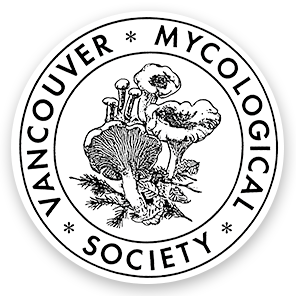By Paul Kroeger
Mushroom cultivation changed drastically just when the Vancouver Mycological Society was formed, with the appearance of novel edible species and new culture technologies. During early years of our club new kinds of fresh mushrooms other than white button Agaricus began appearing in markets and a diversity of both wild and cultivated mushrooms was introduced to the consuming public. Today we are used to seeing a great variety of mushrooms offered as food, but before the VMS it was different.
Public concepts of mushrooms were very different in British Columbia before the 1970’s and for most of Vancouver’s population the word “mushroom” meant just cultivated Agaricus buttons or “Money’s Mushrooms”. We were predominated by British people with Anglo-attitudes including mycophobia, a general cultural fear of fungi; but while most wild mushrooms might be pejoratively dubbed “toadstools” the cultivated button mushroom was embraced with great gusto. At one time Vancouver claimed the highest per-capita consumption of button mushrooms in the world.
Mushrooms were mostly thought of then as a compliment to beef dishes. The consumption of mushrooms was found to be linked to the price of beef so when the meat was more affordable mushroom sales increased. If not served with steak, mushrooms might have mostly appeared in the morning fry-up we call an English breakfast.
Agaricus mushrooms were being grown commercially by a few farmers in BC’s Fraser Valley by 1928, including William T. Money in Burnaby. An agreement was reached among Fraser Valley mushroom growers in 1931 for William Money to handle all marketing and distribution of their mushroom produce. Farmers could now concentrate on mushroom growing and Money’s trucks picked up their crop and delivered it to markets. The entire mushroom crop was sold as a fresh product then.
By 1936 production of mushrooms was excessive to fresh demand so Money built a mushroom cannery to process the surplus crop. When Money retired in 1956 the Fraser Valley Mushroom Growers Cooperative Association was formed and the trade name “Money’s Mushrooms” was purchased for mushroom marketing operations. Around 1940 the slogan “What food these morsels be!” was created and used for many years to promote Money’s Mushrooms; consumption of canned or other processed mushrooms often exceeded fresh sales.
Cultivation was focused on strains of Agaricus harvested young in mass production because white tightly unopened little button mushrooms retain better texture and have more appealing appearance after canning. Prior to the canneries mushroom crops were often harvested just as their caps were opening and delivered fresh to market for immediate consumption with dark gills and deep earthy aromas. Modern agriculture’s industrial mass production and processing had made mushrooms bland and boring.
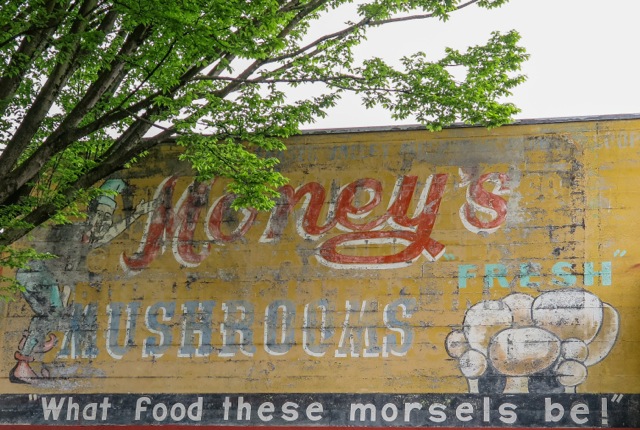
Old advertising mural on Prior Street (photo MDM ) https://vanasitwas.wordpress.com/2016/04/16/what-food-these-morsels-be/
Around 1980 Money’s Mushrooms started a vigorous new marketing campaign with the slogan “Mushrooms make meals Mmmarvelous”; and writer James Barber (The Urban Peasant and author of Fear of Frying) starred in ads and promoted using more fresh mushrooms in different ways and with a greater variety of other foods. Around this time several different Agaricus cultivar strains were introduced, so in addition to white button mushrooms there were also brown varieties, and eventually the large brown Portobello and Cremini mushrooms we regularly see now.
The importation of much cheaper canned mushrooms from abroad, especially from China, had meant that selling their entire mushroom crop fresh was essential to BC producers. By 1985 73% of canned mushrooms consumed were imported from overseas and farmers could no longer afford to grow mushrooms for canning.
Table: Agaricus mushroom production in BC: Fresh vs. processed 1975-1985
From Huang , Hsin Chung 1988 The B.C. Mushroom Industry: An analysis of demand and supply. University of British Columbia M.Sc. Thesis. (* wholesale price / lb)
|
|
fresh quantity lb |
fresh value $ |
price / lb * |
process quantity lb |
process value $ |
price / lb * |
|
1975 |
5,321,000 |
3,859,000 |
$0.73 |
1,926,000 |
949,000 |
$0.49 |
|
1976 |
6,319,000 |
5,189,000 |
$0.82 |
1,797,000 |
896,000 |
$0.50 |
|
1977 |
7,361,000 |
6,610,000 |
$0.90 |
3,549,000 |
2,131,000 |
$0.60 |
|
1978 |
9,576,000 |
8,744,000 |
$0.91 |
3,545,000 |
2,125,000 |
$0.60 |
|
1979 |
9,479,000 |
9,615,000 |
$1.01 |
4,534,000 |
3,245,000 |
$0.72 |
|
1980 |
11,372,000 |
12,616,000 |
$1.11 |
6,487,000 |
4,663,000 |
$0.72 |
|
1981 |
12,624,000 |
16,648,000 |
$1.32 |
6,948,000 |
5,299,000 |
$0.76 |
|
1982 |
13,092,000 |
18,517,000 |
$1.41 |
11,999,000 |
7,988,000 |
$0.67 |
|
1983 |
14,506,000 |
21,026,000 |
$1.45 |
16,346,000 |
10,071,000 |
$0.62 |
|
1984 |
15,492,000 |
24,871,000 |
$1.59 |
15,734,000 |
9,990,000 |
$0.63 |
|
1985 |
15,332,000 |
25,871,000 |
$1.69 |
17,063,000 |
11,085,000 |
$0.65 |
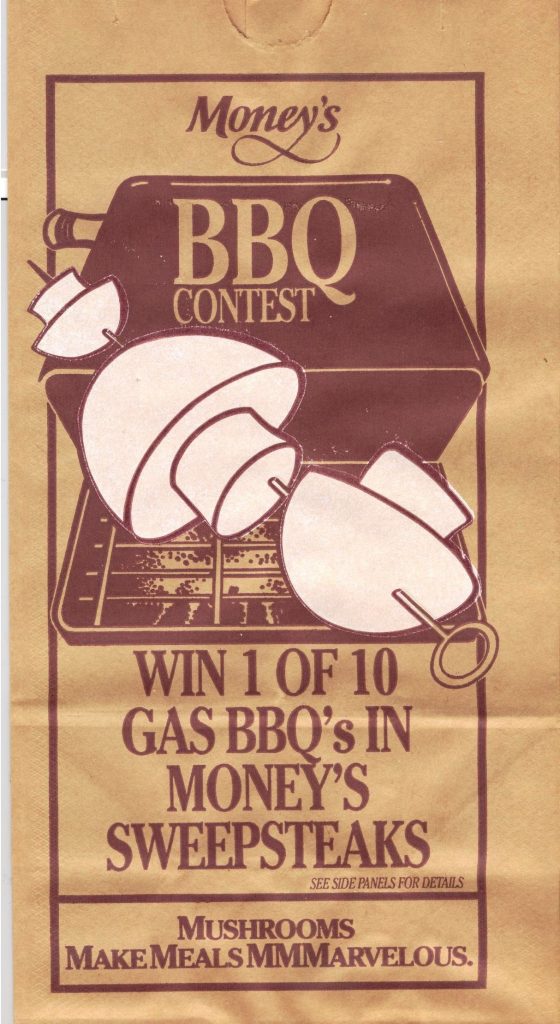
Money’s bag 1990 (photo: Paul Kroeger)
The B.C. Mushroom Marketing Board had been formed in 1966 and was a monopoly which long controlled production and distribution of all mushrooms grown in BC through quotas. Following the introduction of new species and varieties of cultivated mushrooms in the 1980s the mushroom farming industry was transformed. Now a great diversity of fresh edible mushrooms could compete with the boring but still reliable old standard white Agaricus button of the past.
The first BC Shiitake mushroom farms were started in 1979 utilizing drilled and inoculum-plugged deciduous tree logs. Doctor Theodore Takeuchi pioneered the farming of Shiitake on alder logs in British Columbia.
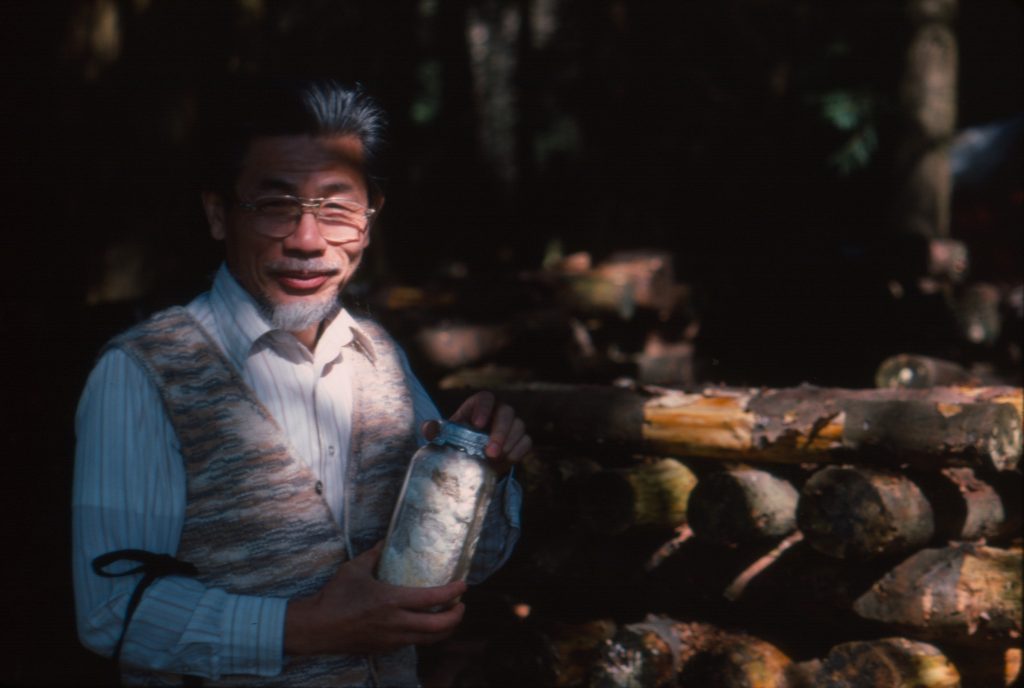
Dr. Theodore Takeuchi Shiitake farm VMS tour 1983 (photo: Paul Kroeger)
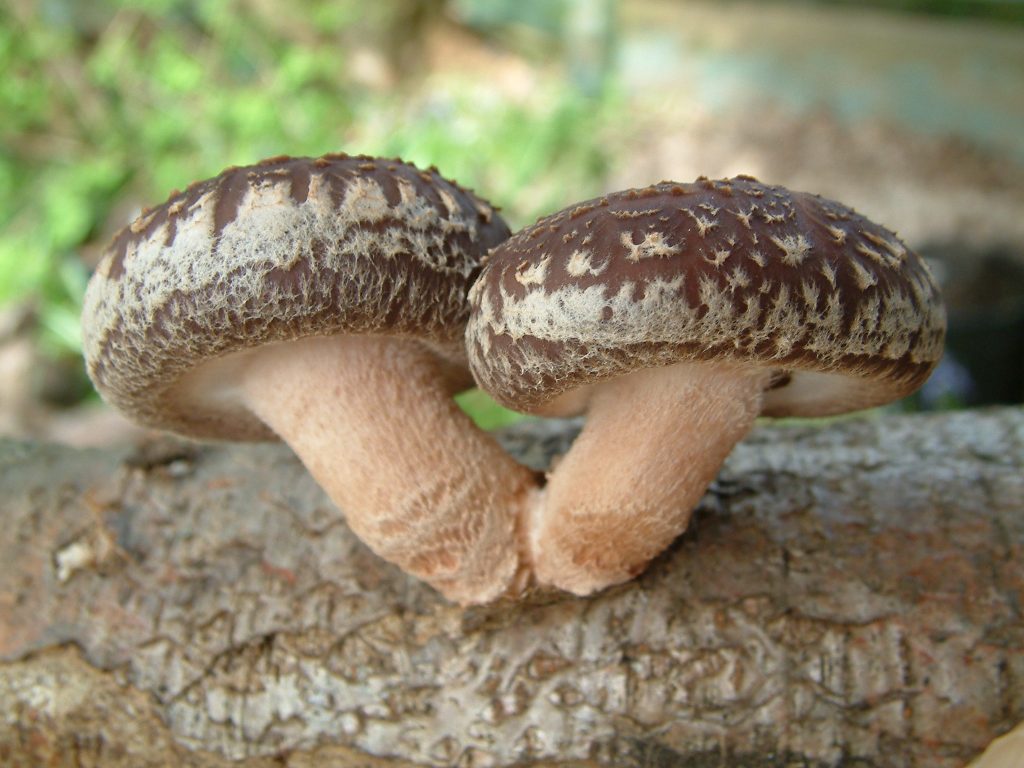
Shiitake Lentinula edodes growing from a log (photo: Paul Kroeger)
Recently developed methods of using artificial substrate mixes formed into tubes, blocks, trays or bags allowed many new kinds of mushrooms to be grown from a variety of materials. Many agricultural wastes or by- products were tested to grow edible fungi. Trials on growing Paddy-straw mushrooms Volvariella volvacea at UBC Agriculture Department showed it wasn’t practical, but discarded materials from the experiment resulted in Paddy-straw mushrooms fruiting from hot steaming large compost heaps at UBC Botanical Gardens and Stanley Park in 1982 and 1983. In 1983 a scheme was hatched to grow Oyster mushrooms on pulp mill waste sludge, a project doomed by association of pulp mills with toxic dioxins.
A more successful and appealing method of mushroom cultivation was developed by Peter Graystone who adapted shipping containers into computer controlled growth modules where Oyster mushrooms grow out of perforated stainless steel vertical trays from alder wood-chip and sawdust in attractive and easily harvested clusters. For many years Peter and his wife Jill introduced people to cultivated gourmet mushrooms at farmers’ markets and our annual VMS shows, and their differently coloured (pink, yellow or blue-grey) Oyster clusters were always a hit.
With introduction of new culture technologies and with a variety of new species available to grow a new hobby was also born, the home cultivation of mushrooms. In early 1970s small scale techniques for growing magic mushrooms were developed for the tropical Psilocybe cubensis and growing “shrooms” became a popular counter-culture hobby. Today most magic mushrooms consumed are cultivated not wild.
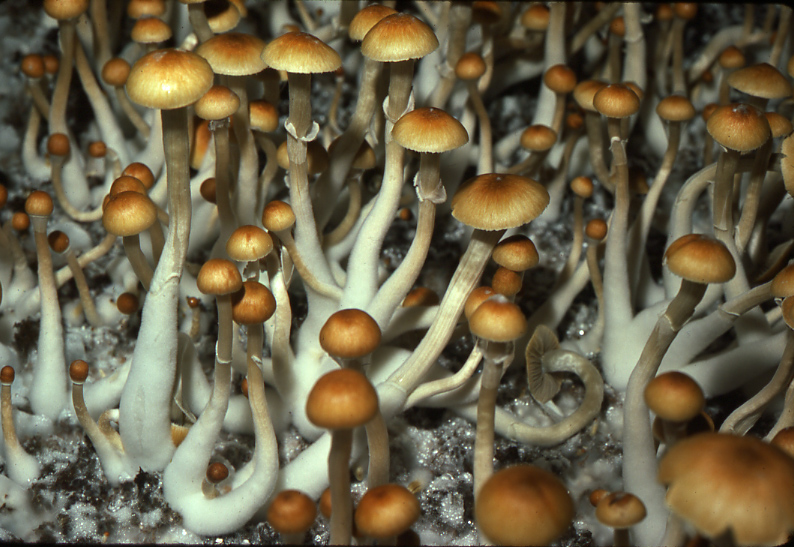
Magic Mushrooms Psilocybe cubensis growing from grain trays in 1977 (photo: Stan Czolowski)
Many magic mushroom growers soon branched out to grow edible species, and eventually other medicinal fungi. Home growing of popular edible mushrooms took off with the development of “space-bags”; flexible thin and sterilizable containers that allow creation of kits consisting of formed blocks or logs of substrate inoculated with mushrooms easily grown at home.
The Mushroom Cultivator 1983 by Paul Stamets and Jeff Chilton was a detailed book that described techniques for growing a variety of different mushrooms, and introduced many people to the science and art of growing fungi. Bill Chalmers had already founded his BC business, Western Biologicals, which provided educational workshops and mushroom grow kits and equipment, supplies and cultures for home cultivation enthusiasts in Western Canada for many years.
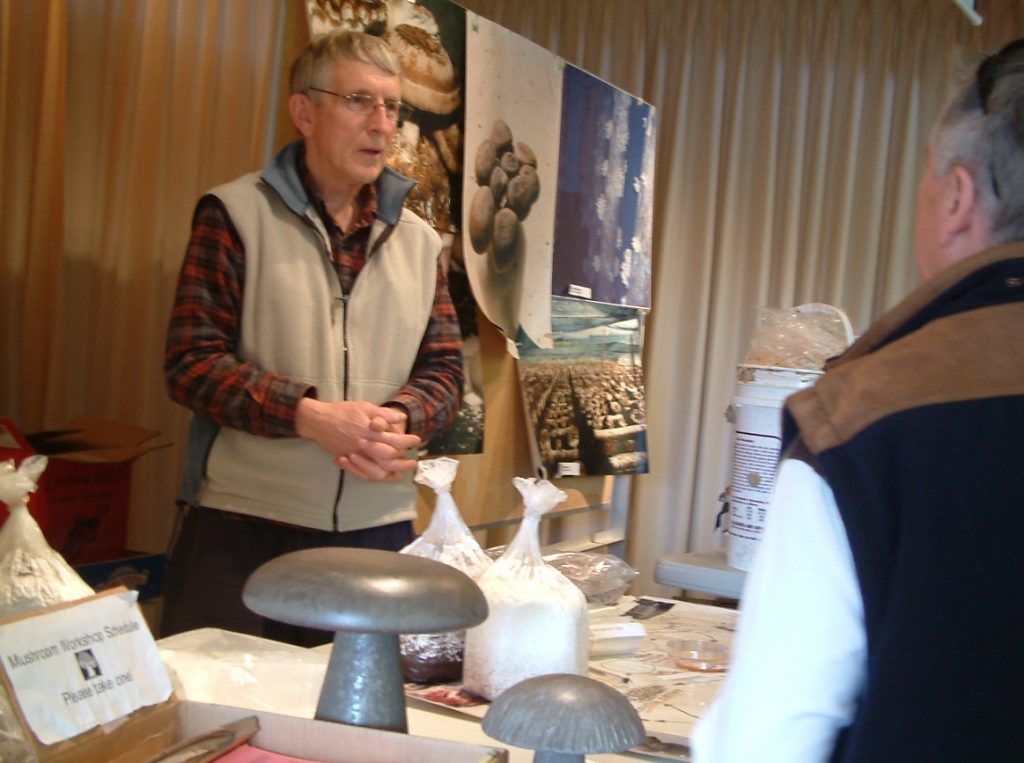
Bill Chalmers cultivation display at 2010 SVIMS show in Victoria (photo: Paul Kroeger)
Concurrent with an expanding interest in finding and growing various edible and magic mushrooms there was increasing awareness of traditional uses of fungi in folk medicines. The 1970s had seen a great interest in natural and herbal medicines and traditional medical practices of different cultures. Fungal moulds had already yielded many valuable drugs such as antibiotics, and different larger fungi and mushrooms were being scientifically investigated for interesting chemical compounds that might have medical potential. Many fungi have a long history of use in Chinese Traditional Medicine and are being studied.
Asian Shiitake mushrooms were introduced to the west with many claims of health benefits and thus promoted as a medicine as well as food. Soon a variety of other medicinal fungi were also available to grow at home and incorporate into gardens.
Reishi or Ling Zhi, the red-lacquered Ganoderma polypores, soon became very popular and highly esteemed in herbal medicine, helped along by a rich folk lore with colourful legends involving mighty Emperors and the great deeds of heroes who were, of course, handsome daring and brave. Most people first heard of Ling Zhi from Gordon Wasson’s 1968 book Soma: Divine Mushroom of Immortality in which the 8th chapter, “The Marvellous Herb”, describes some roles of Ganoderma lucidum in Chinese and Japanese history and folklore.
The Caterpillar fungi, Cordyceps species that are parasites on insects, also became popular and have now become the most expensive mushroom at more than $20,000 a kilogram. It’s perhaps not entirely surprising that robbers armed with pepper bear-spray have held up a couple local Chinese apothecary shops for their Cordyceps sinensis (plus some bird’s nests) making off with $30,000 worth in one incident and $40,000 in another.
Much of people’s fascination with Cordyceps probably derives from its intriguing but rather ghoulish lifestyle and these “Zombie fungi “have truly captured the popular imagination. While Caterpillar fungi are not cultivated much locally except as a novelty, the bright orange Cordyceps militaris is grown overseas and now available here fairly cheap in dried form. In nature it grows from Lepidopteran (butterfly or moth) pupae and is considered a rare find.
There are now numerous species of “medicinal” fungi being sold as herbal teas, medicines and nutritional supplements, and many are being incorporated into drinks and foods. What was a very esoteric subject in the early 1970s, mushrooms as medicine, has now become common knowledge and even somewhat of a fad.
In the early 1990s cultures of the Manchurian mushroom or Tea fungus began to circulate, passed from one person to another as starter cultures much as sourdough bread and ginger beer starters used to be shared. The Tea fungus is a mixed culture of various yeasts and bacteria grown in sweetened tea to produce a fermented beverage called Kombucha. Commercial Kombucha products are now available in stores everywhere in a variety of flavours and there are even dedicated Kombucha tea shops and breweries. There is definitely a Kombucha craze right now and a once obscure cultured folk food from Eastern Europe and Eurasia has become big business.
Another medicinal fungus use that comes to us from Eastern Europe and Eurasia is Chaga or Inonotus obliquus, the cinder or clinker conk of birch trees. After it was mentioned in Aleksandr Solzhenitsyn’s 1966 novel Cancer Ward, this obscure folk medicine has gained increasing notoriety as an alternative cancer treatment as well as a tonic. Scientific research has not kept up with the increasing popularity of Chaga tea and its efficacy as a tonic or for treating cancers in humans remains largely unproven. Excessive consumption of Chaga may actually adversely affect human health due to high oxalate content, with a risk of kidney stone formation and kidney damage. https://www.namyco.org/docs/Oxalates_in_Chaga_a_potential_health_threat_M_Beug.pdf
Chaga is unusual among “medicinal mushrooms” because it’s not really a mushroom or fruit body, but rather a canker formed from the birch tree tissue permeated by mycelium. Oxalates and oxalic acid play vital roles in many wood-decay fungi by weakening and penetrating plant cells through growth of calcium oxalate crystals from mycelial exudates into the wood. Apparently many tree-conk fungi produce oxalates in their mycelium and substrate and continue to do this in artificial culture.
Many available proprietary “medicinal mushroom” preparations actually contain grains grown through with mycelium which are dried and powdered. These products are suspected to be high in oxalates, and have been shown to mostly consist of cereal substrate rather than fungal material. The small amount of fungus present may not even be effective. Several desirable constituents of medicinal mushrooms, such as the triterpinoids called Ganoderic acids found in Reishi, are associated with formation of fruiting bodies and not the mycelium. So, caveat emptor. https://www.nammex.com/redefining-medicinal-mushrooms/
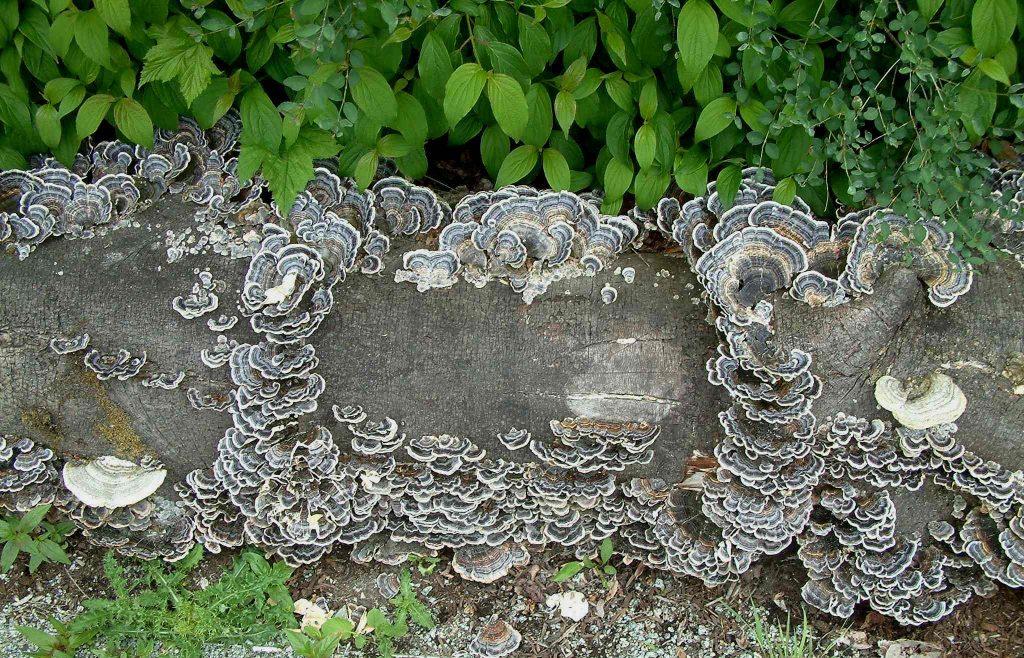
Turkey-tail Trametes versicolor inoculated log at Beaty Museum UBC (photo: Paul Kroeger)
Mycorestoration is the latest catch-word in the mushroom cultivation world. This refers to strategically incorporating fungi into damaged landscapes to restore and enhance ecosystem functioning. The term was introduced and popularized in Paul Stamets’ 2005 book Mycelium Running: How mushrooms can help save the world, along with mycofiltration, mycoforestry, mycoremediation and mycopesticides. But these mycoconcepts are not all new. In 1981 Hellmut Steineck published Pilze im Garten, later published in English as Mushrooms in the Garden 1984, which described how to incorporate edible and interesting mushrooms into home gardens.
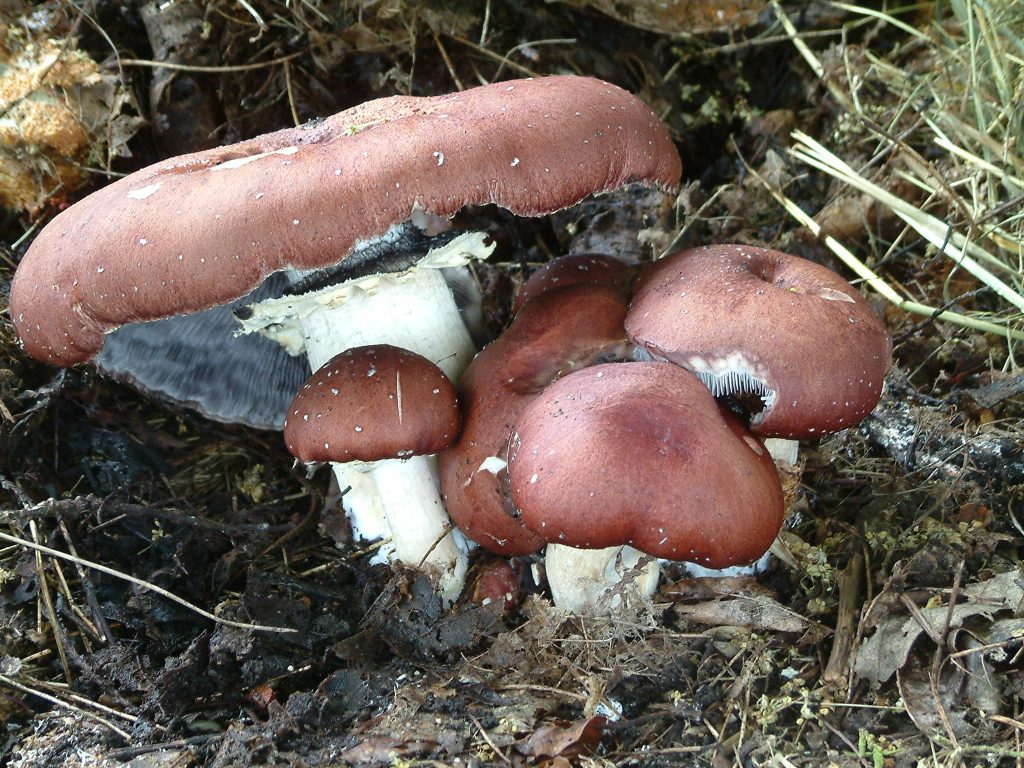
The Garden Giant Stropharia rugosoannulata in compost mulch (photo: Paul Kroeger)
Fungi have great potential to clean up chemical or microbial contamination and as bio-control agents to limit weeds and pests or diseases of plants and animals. Mycorrhizal fungi enhance plant growth and vigour and methods of inoculating plants with mycorrhizal fungi are now widely used in agriculture and silviculture.
Some applications of mushroom cultures for bio-control have been developed in BC. Some years ago inoculum of Chondrostereum purpureum was available to inject into and kill deciduous tree stumps preventing shoot re-growth from removed alder, poplar or maple trees. Oyster mushrooms’ ability to trap and consume minute roundworms may be used to rehabilitate nematode-infested agricultural soils. Hypholoma fasciculare was tested in BC to limit spread of infection from Armillaria (Honey mushroom) root rot centres in forests. https://www.for.gov.bc.ca/rsi/research/cextnotes/extnot33.pdf.
Another popular idea is to use mushrooms to digest and break down hydrocarbons from petrochemical contaminated soils, or in absorbent materials after they’re used to sop up oil spills. Some vigorously growing aggressive saprobic fungi such as the Oyster mushrooms Pleurotus have been shown in test trials to happily feed on hydrocarbons reducing them to harmless products. Obviously the goal here is not to produce mushrooms to eat, but to eliminate the petrochemical contamination. Toxic non-hydrocarbon residues may still remain.
Some fungi promise to help repair damage humans wreak upon our environment, but there are challenges in scaling up such applications to a landscape level and successfully integrating them into communities of other organisms we want to establish in damaged sites. We want to avoid the sorts of unforeseen consequences that seem to bedevil many human attempts to manipulate our natural environment. Some fungi can behave like diseases or weeds and introducing novel fungi into complex landscapes could create whole new problems. The concepts of Mycorestoration sound promising but practical applications in larger landscapes remain mostly untested.
Diverse fungi can be grown to satisfy many needs. Home cultivation is a fascinating hobby that offers mushroom enthusiasts greater insight into how fungi grow while yielding crops of fresh mushrooms for food or medicine. The selection of edible mushrooms available in markets has greatly increased over the past few decades, and some are grown on materials that were previously discarded as agricultural or food-processing waste products.
Mushrooms are very new human cultivated foods in our broader history. Human domestication of plants and animals began some twelve thousand to thirteen thousand years ago. The archaeological record shows that by about ten thousand years ago a Neolithic transformation into pastoral and agricultural communities began as populations settled down to raise animals as livestock and grow plant crops. Fungi first appear in the archaeological record several thousand years ago as residues of yeast-fermented grains on vessel shards. One Natufian site with traces of brewing evidence has been dated as older than 13,000 years before present. https://www.history.com/news/oldest-beer-ancient-brewery-invention.
Humans have fermented beverages and leavened cereal foods with yeasts for millennia, but yeasts aren’t mushrooms. Cultivation of mushrooms, the larger fleshy fruiting bodies of what we call macrofungi, is fairly new to us, only a few centuries not millennia. Asian cultures may have started culturing Wood-ear mushrooms Auricularia species and Shiitake Lentinula edodes several centuries ago, but Europeans were slower to innovate and cultivation of Champignon or Agaricus only began in France in the 1700’s. Most other cultivated mushrooms are much newer on the scene, only a few decades!
The four decades since Vancouver Mycological Society formed has witnessed the spread and growth of an entirely new mushroom culture, a veritable mycocultural revolution. Now the VMS can hold occasional banquets (outside mushroom season) at Po Kong vegetarian restaurant and order a variety of delicious dishes featuring more than a dozen different kinds of cultivated mushrooms.
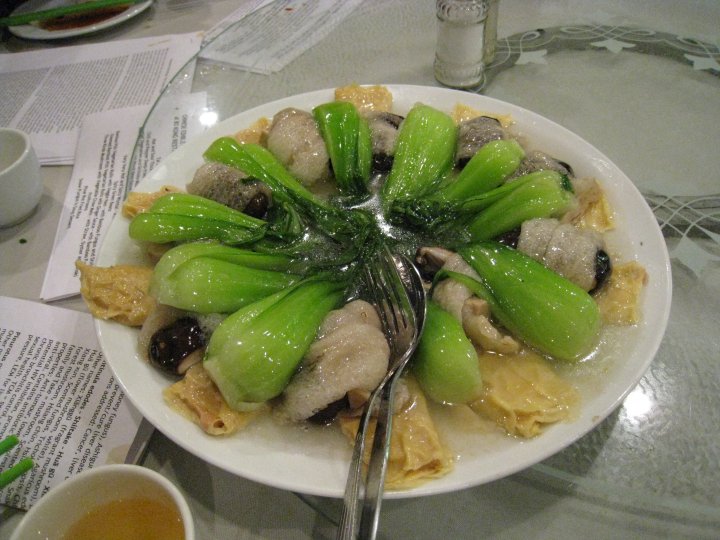
Po Kong “Bamboo pith rolls” Stinkhorn stems stuffed with Shiitake and Enoki (photo: Scott Redhead)
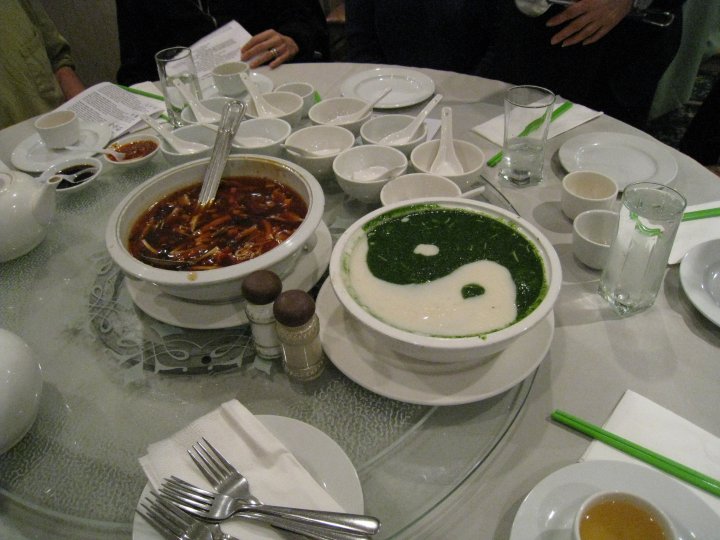
Hot & Sour and Tai Chi soup with Agaricus, Shiitake, Wood-ear and Enokitake (photo: Scott Redhead)
It’s a different world of food from the time of ‘steak and mushrooms’ when only Agaricus buttons were available and canned Money’s Mushrooms were served in Chop Suey houses or found as toppings on pizzas (in 1950s pizza was considered an exciting new exotic ‘foreign food’). Cultivation of a variety of mushrooms has helped diversify modern cuisine and it’s much more interesting now. “What food these morsels be!” indeed; many more mushrooms really do make meals marvellous.
